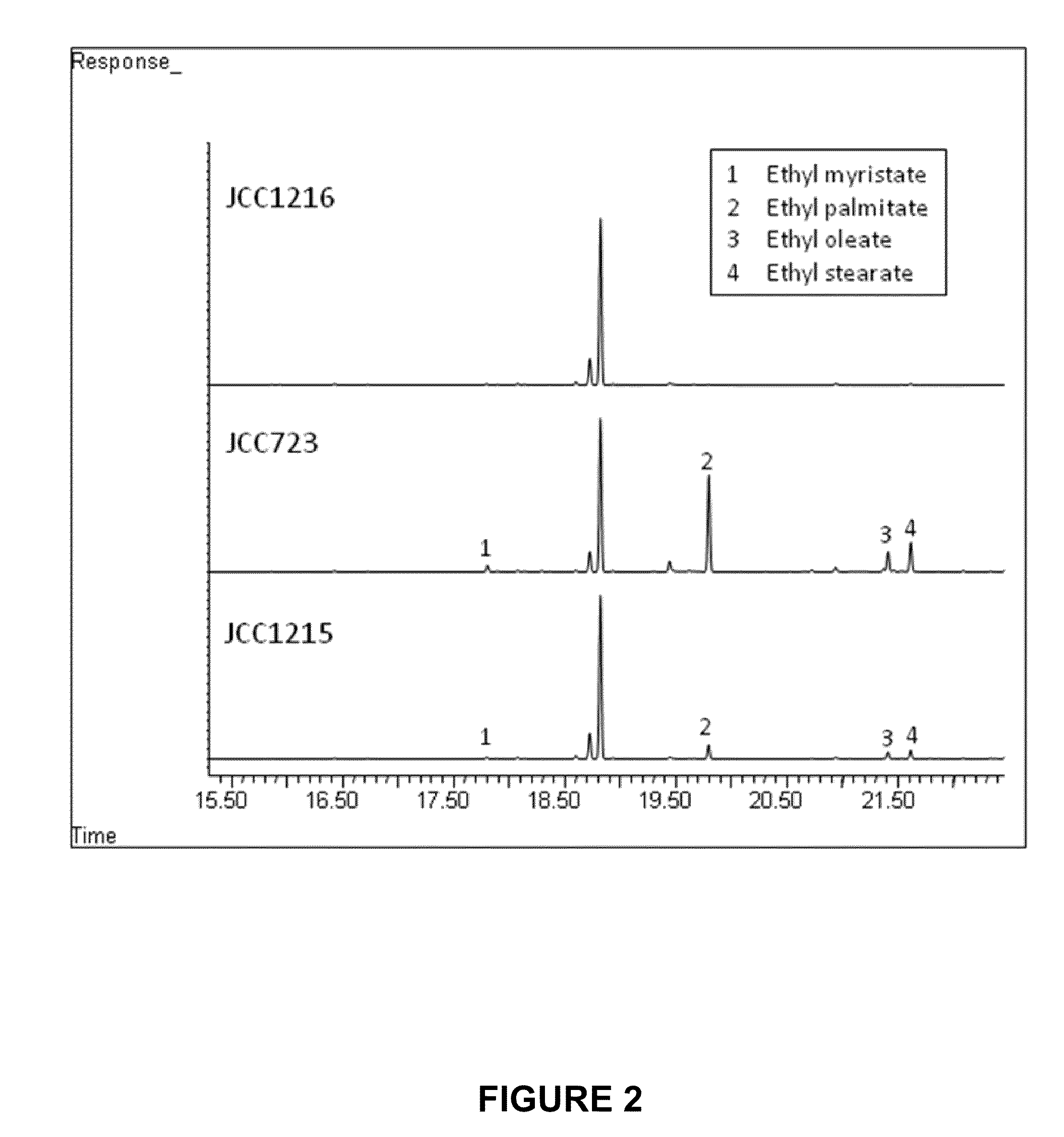Methods and Compositions for the Recombinant Biosynthesis of Fatty Acids and Esters
a technology of fatty acids and esters, which is applied in the direction of lyases, ligases, enzymology, etc., can solve the problems of poorly suited photoautotrophic organisms, plants, algae, etc., and not demonstrated commercial viability
- Summary
- Abstract
- Description
- Claims
- Application Information
AI Technical Summary
Benefits of technology
Problems solved by technology
Method used
Image
Examples
example 1
Recombinant Genes for the Biosynthesis of Biodiesel and Biodiesel-Like Compounds
[0138]In one embodiment of the invention, a cyanobacterium strain is transformed or engineered to express one or more enzymes selected from the following list: a wax synthase (EC: 2.3.175), a thioesterase (EC: 3.1.2.-, 3.1.2.14), and an acyl-CoA synthase (EC: δ 6.2.1.3). For example, a typical embodiment utilizes a thioesterase gene from E. coli (tesA; SEQ ID NO:1), an acyl-CoA synthetase gene from E. coli (fadD; SEQ ID NO:2), and a wax synthase gene from A. baylyi (wax; SEQ ID NO:3). Thioesterase generates fatty acid from acyl-ACP. Acyl-CoA synthetase (also referred to as acyl-CoA ligase) generates fatty acyl-CoA from fatty acid. Wax synthase (EC 2.3.1.75) generates fatty acid esters using acyl-CoA and acyl alcohol as substrates (e.g., methanol, ethanol, butanol, etc).
[0139]Additional thioesterase, acyl-CoA synthetase and wax synthases genes that can be recombinantly expressed in cyanobacteria are set f...
example 2
Synthesis of Ethyl and Methyl Fatty Acid Esters by an Engineered Cyanobacterium
[0142]Genes and Plasmids: The pJB5 base vector was designed as an empty expression vector for recombination into Synechococcus sp. PCC 7002. Two regions of homology, the Upstream Homology Region (UHR) and the Downstream Homology Region (DHR), are designed to flank the construct of interest. These 500 bp regions of homology correspond to positions 3301-3800 and 3801-4300 (Genbank Accession NC—005025) for UHR and DHR respectively. The aadA promoter, gene sequence, and terminator were designed to confer spectinomycin and streptomycin resistance to the integrated construct. For expression, pJB5 was designed with the aphII kanamycin resistance cassette promoter and ribosome binding site (RBS). Downstream of this promoter and RBS, the restriction endonuclease recognition site for NdeI, EcoRI, SpeI and PacI were inserted. Following the EcoRI site, the natural terminator from the alcohol dehydrogenase gene from Z...
example 3
Production of Fatty-Acid Esters Through Heterologous Expression of an Acyl-CoA Synthetase and a Wax Synthase
[0156]In order to compare the yields of fatty-acid esters produced by recombinant strains expressing tesA-fadD or fadD-wax (i.e., two of the three genes in the tesA-fadD-wax synthetic operon), fadD-wax and tesA-fadD and were assembled as two-gene operons and inserted into pJB5 to yield pJB634 and pJB578, respectively. These recombination plasmids were transformed into Synechococcus sp. PCC 7002 as described in Example 1, above to generate the strains listed in Table 8. Table 8 also lists JCC723, described above.
TABLE 8Joule Culture Collection (JCC) numbers of the Synechococcus sp. PCC 7002recombinant strains with gene insertions on the native plasmid pAQ1.Promoter-operon% DCWStrain #PromoterGenessequencesMarkerOD730FAEEJCC723PaphIItesA-fadD-waxSEQ ID NO: 10aadA15.350.20JCC1215PaphIIfadD-waxSEQ ID NO: 13aadA10.100.04JCC1216PaphIItesA-fadDSEQ ID NO: 14aadA10.000.00
[0157]One 30-m...
PUM
| Property | Measurement | Unit |
|---|---|---|
| Fraction | aaaaa | aaaaa |
| Fraction | aaaaa | aaaaa |
| Fraction | aaaaa | aaaaa |
Abstract
Description
Claims
Application Information
 Login to View More
Login to View More - R&D
- Intellectual Property
- Life Sciences
- Materials
- Tech Scout
- Unparalleled Data Quality
- Higher Quality Content
- 60% Fewer Hallucinations
Browse by: Latest US Patents, China's latest patents, Technical Efficacy Thesaurus, Application Domain, Technology Topic, Popular Technical Reports.
© 2025 PatSnap. All rights reserved.Legal|Privacy policy|Modern Slavery Act Transparency Statement|Sitemap|About US| Contact US: help@patsnap.com



